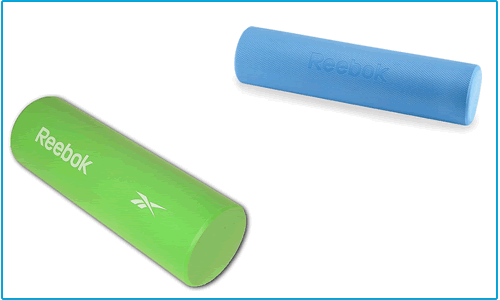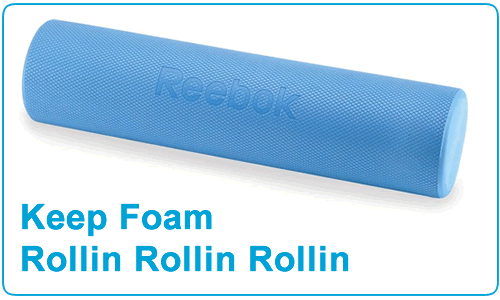A Look at the Strange Piece of Exercise Equipment and Why You Should Embrace the Pool Noodle’s Chubby Cousin.
If you’ve been to a gym lately, you’re bound to have encountered a foam roller. Although the foam roller looks like a “noodle,” the popular pool toy of the 90s, it’s actually supposed to be used on dry land. Unlike many fitness tool fads, the foam roller is here to stay and we encourage you to find one and roll out daily. This article will explore what foam rolling is, how to use one, and why you should start foam rolling today.
What is foam rolling?
The art of foam rolling is basically a type of self-massage performed by rolling a specific muscle back and forth over this piece of equipment. Exercise causes small tears in your muscle fibers, which can lead to scar tissue over time. Foam rolling reverses this process by breaking down adhesion and in turn increasing blood flow to the area. Foam rollers come in different densities to help you change the amount of pressure put on a given muscle and the connective tissues around it as you work out evil muscle knots.
Foam Roller Testing
After road testing eight different brands of foam rollers I would recommend the Reebok version, it is by far the best quality and will last the test of time.
Check it out at the Reebok store:

Why should I do it?
Foam rolling is a great way for experienced and beginning exercisers to prevent injury. If you continue to exercise and cause small muscle tears to go untreated, a trigger point (also known as a muscle knot) can form. Using a foam roller on this area can release the knot and help muscles go back to their natural lengthened shape. If a muscle knot is left untreated, it can impact other areas and tissues causing the exerciser to alter their form and ultimately leading to injury.
Foam rolling has other benefits in addition to preventing muscle imbalances and injuries. This self-massage technique will keep you from spending money on a professional sports massage. Money you can use for a more relaxing form of massage at a later date. Lack flexibility? Foam rolling can also help improve the range of motion in your joints. With so many benefits to your exercising and money saving routines, a better question would be why aren’t you foam rolling right now?
Foam rolling technique
Now that you know what foam rolling is and why you should try it, you might wonder how to get started. You’ll need a foam roller and your body to start your self-massage. Find a muscles area that feels tight or a muscle knot. Common areas to foam roll are the hamstrings (back of the thigh muscles), quadriceps (front of the thigh muscles), iliotibial band (runs from the knee to the hip on the outside of your leg), and upper back. Lie on the foam roller with the muscle of your choice touching this equipment. Use your body weight to press this area into the foam roller as you roll back and forth over it. If you find a trigger point, you didn’t think you had, you’ll know it! This area will feel painful. Hold the foam roller on this position for 30-45 seconds to help work out the muscle tightness. Continue your foam roll for 1-2 minutes remembering to breathe and keep your abdominal muscles tight to keep your body stable. Foam rolling techniques can be performed daily.
Foam Rolling for Runners
A prime example of a good candidate for foam rolling is a veteran runner. Running long distances causes small muscle tears especially along the iliotibial or IT-band. This area runs from the knee to the hip on the outside of your leg and as such is very important for helping a runner get from place to place. Even exercisers who have no noticeable issues in the IT-band area at rest are bound to find a trigger point or two when rolling over this area. Foam rolling the quadriceps and hamstrings is also important and should be done as often as possible to increase range of motion in these muscle groups.
Other uses for Foam Rollers
While you may have a foam roller at your neighbourhood gym, we recommend you buy one to keep at home. This way you can purchase one with the correct density for your body and practice the technique daily. You’ll also be able to use the foam roller for other reasons. Increase the difficulty of your plank or push-up by including your foam roller. Place one or two hands on top of the foam roller during either exercise or secure the tool under your toes and add some extra core work. The uneven surface will require your body to recruit more core (read ab and back) muscles. Foam rollers can also be used for general balance work. Start by trying to balance on one using the support of a wall. Need another reason for buying this strange looking tool? You can put your foam roller to work at the end of a long day by using it to get a foot massage. While standing. rest one foot on top of the foam roller and use it to massage the arch of your foot by rolling it back and forth across the tool.
If you’ve been afraid to check out a foam roller, we hope these tips encourage you to embrace this new exercise tool. Use the foam roller often to massage out some muscle knots, help prevent injury, and work on your balance. If you found this post helpful, please share it with your friends. If you have a question about foam rolling technique, feel free to drop us a line in the comment section below:
